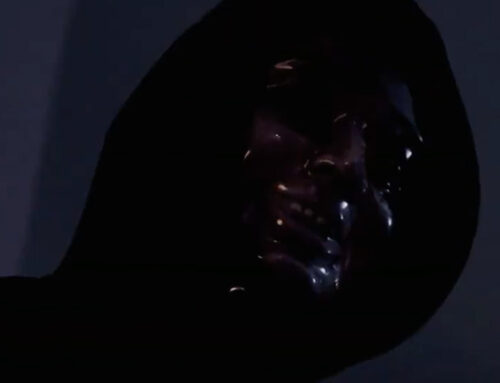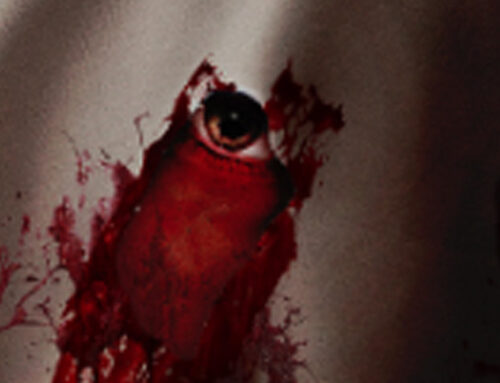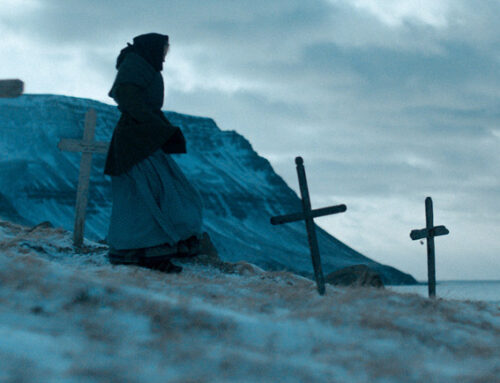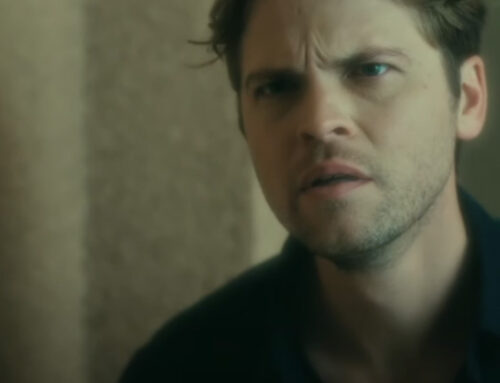Yesterday, we shared our review of the new horror pic Still/Born. Written and directed by filmmaker Brandon Christensen, the movie follows a woman suffering from the loss of one of her twins during childbirth. If that isn’t tragic enough, an unseen, supernatural force is intent on stealing her surviving child as well. The film is a surprisingly good horror movie that demonstrates what good writing can do on a smaller budget.
We were able to talk with Christensen about the film, his writing process with co-writer Colin Minihan, and the process of making such an effective movie.
 HorrorBuzz: I wasn’t expecting to like the movie as much as I did!
HorrorBuzz: I wasn’t expecting to like the movie as much as I did!
Brandon Christensen: Because it’s called Still/Born.
HB: Well that is a downer of a title (Laugh) No seriously though, the movie gave me my first good scare of 2018. Where did the idea for this film come from?
BC: The idea came from this singular image I had of a woman delivering a baby, with the first one coming out fine and the other… The nurse delivering the baby looks at the mother and there is this moment. Then showing the mother holding one baby in a nursery with two cribs. So I said hey, I have this idea, what can we do with this? So Colin Minihan and I began to research postpartum and go from there. Then I was also pulling from my own experience as a dad. With the baby monitors, those are the same monitors we had. I mean, we don’t use them anymore, but. You just sort of sit there in bed, watching your baby through this monitor and your mind goes to the worst place like, “What if someone just grabbed the baby right now?” So I was able to draw from the things. And Minihan, he was hugely influential in just building this story with me. We worked together nonstop. We would be face timing while I was making lunch for my kids and he would be furiously typing away in a google doc that we were building.
HB: So you just pictured a single scene and built from that.
BC: Pretty much. I mean we were looking for a contained idea for a horror script and that mental picture just came to me in a two-page scene and I wrote it down and we went from there. You know, we asked, “Where could this go?”, “What would happen to a woman who had one child die at birth?”, and the other thing was, “Where does that story lead us?” We were brainstorming nonstop on FaceTime until we had a pretty good idea of where we wanted it to go and we had a breakdown of the entire film. We wrote a really terrible first draft, then we kept polishing it until we had something pretty close to what we ended up shooting.
Brainstorming is always tough because you don’t want to have a stupid idea, but it was a very welcoming environment to pitch ideas in. Even a bad idea could lead to something good. If you don’t explore everything you don’t know where it may lead. Having never written a feature before it was a great experience to see where each one of these rabbit holes goes.
HB: What was your background?
BC: I’ve been a director, just kind of doing commercials and stuff like that for a little while. I did a ton of music videos and played around with friends doing stuff. But when Colin had his script for It stains the Sands Red we had been friends for a long time. I told him, hey you guys come out, and we ran around Vegas scouting locations and I was really kinda pushing them into shooting there. I thought it would be a great opportunity. Then a month later we’re in pre-production on it.
Doing that I definitely stepped out of my comfort zone. I’ve got a wife, family, and kids, so jumping into low-budget features isn’t exactly the smartest movie but it was the move that I felt like I wanted to take and by doing that Colin helped me to have the opportunity to direct my own film and that’s what Still/Born is. We were definitely building something where we could make more films and keep the ball rolling.
HB: We caught It Stains the Sands Red at LA Film Festival.
BC: Oh Yeah, I was there!
HB: There was a great use of humor in It Stains the Sands Red and you use it again in Still/Born. In particular in the beginning with the scenes between Rachel and Mary that I found very interesting. Can you tell me why you used that and if that enhances the scares later?
BC: Horror is definitely a game of contrasts. If you look at something like Get Out and you have this hilarious comedy director in Jordan Peele and you place him in a situation where he is also gonna scare you, it’s effective. The farther you pull on one side the farther it’s gonna go on the other side and you will just feel it more. So in Rachel’s case, I think the comfort level that married couples have is funny. You’ve got this sort of shorthand. It’s not that you don’t love the person, it’s that you are incredibly comfortable. I think horror works best when you are sort of tugging in that other direction. You are pulling on something that is the opposite f horror, so when you have that jump scare you feel it more because you have been lulled into this false sense of security and so I think that is really important in comedy too. I like the comedies where it’s not just gag after gag, but that have these really personal moments punctuated by the comedy, you feel it even more.
HB: Like a relief.
BC: Yeah exactly.
 HB: Christ Burke was great in the movie. Did you have a hard time finding someone for the role?
HB: Christ Burke was great in the movie. Did you have a hard time finding someone for the role?
BC: Well, we had a difficult time putting that on someone and knowing what it was gonna take but Christie had such a great audition video, that we knew that she could do it. Still, it is hard when you have 20 days and you are just putting them through the wringer with emotions, crying one scene and being normal in the other, you never know how it’s gonna go. In this case, she had six days to herself. Jesse Moss, who plays her husband, wasn’t available until the second half of the shoot. So we did six days of her alone then we started bringing in the neighbor, then the old woman. When she had those six days alone we started with her cleaning the house, then the next minute she is crying over an empty crib, just throwing her through the gauntlet of emotions. I mean, that can break someone, where you have half the scenes where she is happy and half where she is sad. It’s a tremendous amount of pressure to put on someone. What’s more, she had never been the lead of a film before so this was as big a test as any. I think she did a great job.
HB: No, she did a phenomenal job.
BC: The movie kind of lives and dies with her.
HB: You had to be interested in her and you had to actually like her. She did all of that.
BC: I think that goes with what you were talking about earlier with humor. You had to like her as quickly as possible. You look at the book, Save The Cat and it says, “Make the hero someone you can like by having them save a cat figuratively.” Then the audience is on their side. So when they get put through this horrible situation the audience is rooting for them.
HB: What is it that makes the scare effective?
BC: Well there are different types of scares. There’s the jump scare which is the easiest get out of someone. If you have an effective sting sound that will make the audience jump that is half the work right there. I think it is just playing with expectations. There is one thing I did that I thought was pretty effective; There’s the rule of three’s where you expect something to happen on the third beat. I used that in the air vent scene where she’s looking into the vent and getting closer and closer. You think that on the third cut you will see something but it doesn’t, it happens on the fourth one.
Horror is such a broad thing now. I mean there are so many kinds of horror that affect people so many different ways. It is kind of hard to say. I like atmospheric horror where things are all quiet and you don’t know what’s going to happen. That’s where jump scares work really well. It’s tough to say. It’s really just playing with expectations.
HB: What is it that kills a scare?
BC: Showing too much. I mean look at Jaws. They couldn’t show the shark because it wasn’t working. I think its the fear of the unknown. I remember when I was in the sixth grade, my mom and I were watching The Shining on Halloween. Every time there was a scare my mom would cover my eyes because she thought if I didn’t see it that would help. But what that did was make me imagine, “Holy shit if this so scary that I shouldn’t see it I can’t imagine what it is!” It’s like, “What is it on screen?” Then your imagination begins to roll, and you come up with something that is probably a lot scarier than what they ended up showing. I think that if you don’t leave enough to the imagination, at least until the end if you show too much too soon, it becomes less of a threat. Look at Signs. There is that great scene with the birthday party footage where the alien walks out of the bush and you are like, “HOLY SHIT! that’s confirmation.” but you don’t get to see everything or the moment with the foot in the cornfield. You are kept in suspense until the end where there is a big blowout. I mean, in the case of Signs it’s a scene in the living room and that’s debatable whether or not that works. In general, you should just keep the audience guessing.
HB: Where did you film?
BC: We shot in Alberta Canada, at my parent’s house.
HB: Oh wow! Did you have any paranormal things happen on set?
BC: No, I wish I had a fun anecdote, but no. You are shooting twelve hours a day, five or six scenes a day… Making a film you are so detached. You have a scraggly woman walking around on set and being all scary. At that moment it’s totally normal. But on the screen, it looks terrifying. When you are shooting there are so many things you are worried about that there isn’t time to think about anything else. When you go to bed you are just knocked out.
HB: If something did happen you were probably way too busy to deal with it.
BC: Probably, I mean it’s like, “Look demon I really don’t have time for this.”
HB: As a male writer did you find it difficult to write about postpartum?
BC: It’s difficult to write about the opposite sex simply because people are complicated and it’s hard to get a grasp on that. But I have been married for ten years now and have two kids. I have seen and experienced how you deal with kids as a parent and the strength that comes out of a mother, you don’t really know it’s there until it happens. My son had skull surgery when he was 8 months old. He was in the hospital for like 6 days and my wife never left his side. You see these things and you kind of see what is in these people. The movie deals a lot with being in those moments of needing help and being strong when you shouldn’t be so I think a lot of Mary’s problems stem from her not asking for help when she needed to and not being open with what was happening to her husband or to the psychiatrist. But there is this disconnect with her husband because she lost a child but he still has a child and he’s not being very empathetic as he could be. We looked into a bunch of case studies on paranormal psychosis and I would bounce ideas off of my wife to get her take on it as well. But it’s definitely challenging to write.
HB: What’s coming up next for you?
BC: I am writing a script with my wife actually. In the same vein as Still/Born actually, a sort of family drama. We want to do a set of three horror films featuring moms so that we can sell the set at Was-Mart for $4.99 and call it the Mama Trauma Trilogy. Get some really bad box art on it.
HB: I like your thinking.
BC: No, but seriously we are working on a script together and my wife is pregnant again and we thought, “maybe we should do another Still/Born movie because we have a free baby to use.”
HB: I mean it’s free. Well, I really enjoyed the film, I thought it was very effective. Keep doing what you are doing!
BC: Alright thanks, man!
STILL/BORN is out now in Theaters and on VOD
| Still/Born | ||
| RATING: | R | Still/Born | Official Trailer (HD) | Vertical Entertainment |
| Runtime: | 1hr. 27Mins. | |
| Directed By: | ||
| Written By: | ||







